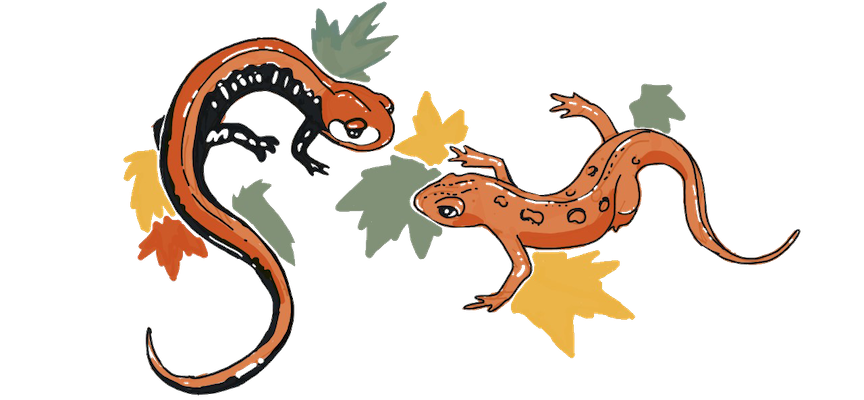
Dora Guo
Two summers ago, Angus Mossman ’18 spent hours in the Yale-Myers Forest picking up decaying logs and looking for salamanders to conduct research for his senior thesis.
Mossman’s research investigated the impact of forest harvesting on eastern red-backed salamanders and eastern newt populations. His work found that eastern red-backed salamanders thrived within soft wood that decayed from a timber harvest 25 years ago. On the other hand, the eastern newts preferred untouched, mature trees.
“If [the eastern red-backed salamander and eastern newt] are some of the most common species in the forest, and we have no idea how they respond to environmental change, how the heck are we ever going to understand what happens to more rare species?” said co-author Max Lambert GRD ’18.
Mossman said that one part of the study involved measuring wood pieces and determining their volume. He then graded them “on a one-to-five scale of how squishy they were,” Mossman explained. One meant that the tree had just fallen over and five on the scale meant that the piece “looked like dirt and was covered in moss,” he said.
Mossman explained that the squishier the wood, the longer it had decayed, allowing him to understand how recently that area of the forest had been harvested. For plots which had been harvested within the past decade, the wood debris on the ground was still fairly intact, which made it difficult for salamanders to find shelter. In plots that were harvested roughly 25 years ago, however, the wood debris had decayed enough to create dark and damp habitats for the salamanders.
“I thought it was great because you would see a dead log and think, ‘Oh, that’s just a dead log,’ and you’d start to pick through it and would find all this cool stuff,” Mossman said, describing his research methodology. “There were salamanders, frogs, all these cool insects and worms and millipedes. It’s like a whole new world in there!”
The study found that the eastern red-backed salamander population declined sharply after harvesting, and then recovered and surpassed its initial size from untouched plots. The eastern newt population, however, never recovered after timber harvesting.
Mark Ashton, director of the Yale-Myers Forest and co-author of the paper, explained that regenerative timber harvesting — a process by which certain areas of the forest are harvested to make way for natural regeneration — is used to ensure the forest has high biodiversity. It is intended to mimic natural disturbances, according to Ashton, who described the process as being like a tiny windstorm or tornado.
“They create a mosaic of cuts here and there, creating a patchwork of different niches,” explained Lambert. “This allows there to be open areas that help some species and some areas that are shaded and uncut to help other species.”
Marlyse Duguid GRD ’17, director of research for the Yale School Forests and senior author of the study, explained that shelterwood timber harvesting generally leaves the ground and part of the canopy intact. This lets in enough light for new tree growth to occur while also leaving behind some structures for wildlife.
The Yale-Myers Forest relies upon the sale of timber to companies to sustain its management, according to Duguid. But Mossman noted that timber harvesting is also crucial to maintaining forest diversity.
“This shows that timber harvesting can be important. It can create salamander habitats if done in a way that is a small-scale disturbance among an intact forest,” Mossman said. “Logging and forestry practices can benefit forests; they’re not always bad.”
Mossman conducted the research over a summer for his senior thesis. His work with the two species suggests that there is potential for further research on this topic to strengthen the study’s findings.
“I grew up swimming around in ponds and chasing after frogs and turtles and that kind of thing, so it’s very near and dear to my heart,” Mossman said. “I think it’s really fun to look for things outside, and especially things like salamanders that you so rarely get to see.”
The study was published in the biological, environmental and medical sciences journal PeerJ on Aug. 30.
Julia Brown | julia.k.brown@yale.edu







